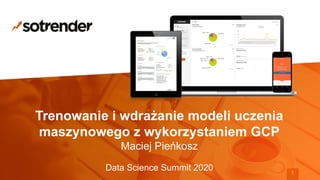
Machine Learning Model Training and Deployment with Google Cloud Platform
- 1. Trenowanie i wdrażanie modeli uczenia maszynowego z wykorzystaniem GCP Maciej Pieńkosz Data Science Summit 2020 1
- 2. What we do at Sotrender 2
- 3. Our models 1. Sentiment 2. Hatespeech 3. Topic modelling 4. Keyphrase extractor 5. NER (brands and products) 6. Image Tagger 7. Text Extractor 8. Logo Detector 9. Post Classifier 10. …. 3
- 4. ML models lifecycle 1. Planning and project setup 2. Data collection and labeling 3. Modeling and exploration 4. Model training and refinement 5. Testing and evaluation 6. Model deployment 7. Ongoing model maintenance and monitoring 4 https://www.jeremyjordan.me/ml-projects-guide/
- 5. Modeling with AI Notebooks 1. We use Google Cloud Platform as our cloud provider 2. AI Platform Notebooks is used for initial data exploration and modeling 3. For the start, we favor faster, simpler model architectures that can be easily built, validated, iterated and eventually deployed (usually on CPU) 4. Experiment tracking: MlFlow 5 https://databricks.com/blog/2018/06/05/introducing-mlflow-an-open-source-machine-learning-platform.html https://cloud.google.com/ai-platform-notebooks?hl=id
- 6. Structuring training code • Notebooks disadvantages: – You pay for the whole time the notebook is running – Code quality is usually lower – Hard to parametrize, unit test, and review • After initial experimentation phase, we try to give more structure to the model training code: – Refactor codebase to Python packages and modules and move to git repository (Gitlab) – Add tests (more on it later) – Wrap code into a Docker container – Use dedicated AI Platform Training service to train in the cloud 6 https://www.jeremyjordan.me/ml-projects-guide/
- 7. AI Platform Training with custom containers 7 • Advantages: – Develop locally, train in the cloud – Pay only for the time of training – Broad configuration options – Job statuses and logs for historical runs are available in the dashboard – Easy integration with hyperparameter tuning Training job dockerfile Cloud training script
- 8. Google Storage for Models and Datasets • We use Google Storage as primary Store for models and datasets • One bucket per model • We follow unified bucket and directory structure, same for every model – Raw data – Combined datasets, with predefined splits – Model files • Documentation in Knowledge Base (Confluence) • One can use dedicated systems like DVC, Quilt 8
- 9. Additional training tips • Consider having two validation sets: training-dev and test-dev, to distinguish between overfitting errors and distribution shift • Establish human performance for your task • Evaluate your model performance on important data slices • Do hyperparameter tuning; utilize open source packages e.g. hyperopt • Develop a systematic way of analyzing model errors Recommended resources: • https://www.coursera.org/learn/machine-learning-projects • https://www.deeplearning.ai/machine-learning-yearning/ 9 https://towardsdatascience.com/some-strategies-for-machine-learning-projects-5f2f32c34635
- 10. Model deployment • Your options: – Online – Batch (offline) • Our approach is to deploy models as services – Easy to integrate – Easy to use by other teams • We serve them as REST service with Flask (or, most recently, FastApi) • We wrap them in Docker containers so they can be easily deployed to cloud and serve with Cloud Run 10 https://mlinproduction.com/batch-inference-vs-online-inference/ Online inference Batch inference
- 11. Cloud Deployment: Cloud Run • We use Cloud Run to deploy our model services • Cloud Build for delegating build process to GCP • GCP has dedicated service for serving models, AI Platform Prediction, but we use Cloud Run – It is more flexible for us, we can set up any environment and add any dependencies – AI Predictions has limits regarding model size – We can add additional endpoints (e.g. /explain to services) 11 Service dockerfile Cloud deployment script
- 12. Cloud Run c.d. • Useful features out-of-the box – Autoscaling – Multiple Revisions (versions), easy Rollback – Traffic management – Multiple Namespaces (dev, prod) – Resource Monitoring 12
- 13. Delivery pipeline automation (CI/CD) 13 • Implemented in Gitlab CI/CD push Download files Build image Run tests Run static analysis Push image to registry Code Review Canary rollout deploy
- 14. Testing and evaluation • Unit and integration tests for: – Input pipelines – Preprocessing functions • “Regression” tests for: – Performance on validation data – Predictions on some important, hand-picked examples – Performance on data slices 14
- 15. Monitoring • System level metrics: – Resource consumption (RAM, CPU), healthchecks, status codes, latency, etc. • Data level metrics – Prediction distributions, input data distributions – System performance against real time labels (collected automatically or manually) 15 https://mlinproduction.com/
- 16. Streamlit • https://www.streamlit.io/ • Easy tool to create simple web Data Products directly in Python • You can use it to create Demos, share your work, showcase your models behaviour, debug • Very intuitive, no Web skills required 16 https://towardsdatascience.com/coding-ml-tools-like-you-code-ml-models-ddba3357eace
